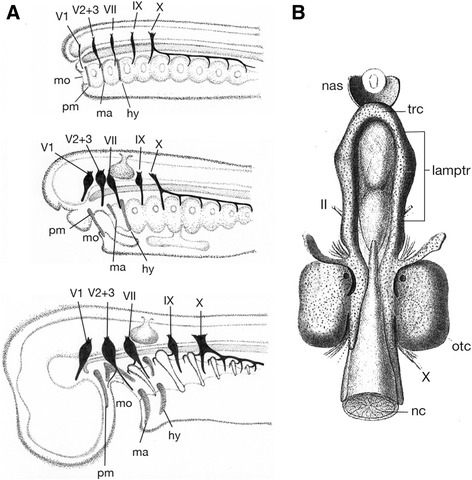Fig. 2.

Evolution of the vertebrate neurocranium and origin of trabecula. a Scenario by de Beer. From top to bottom, amphioxus-like vertebrate ancestor, ammocoete larval-like intermediate state, and gnathostome morphotype resembling an elasmobranch pharyngula. The trabecula is assumed to represent the premandibular arch, which was secondarily incorporated into the neurocranium of the gnathostome whose forebrain is expanded enormously. Based on reference [11]. b The neurocranium of the adult lamprey, which is primarily formed of an inverted U-shaped ‘lamprey trabecula’, rostrally connected with its counterpart by means of the rostralmost portion called, in the present paper, the ‘transverse commissure’. The latter part is assumed to be of premandibular mesoderm and homologous with the orbital (acrochordal) cartilage of jawed vertebrates, and the rest of lamprey trabecula is thought to correspond to a rostrally extended parachordal. This figure is based on reference [31]. Abbreviations: hy, hyoid arch; II, optic nerve; IX, glossopharyngeal nerve; lamptr, lamprey trabecula; ma, mandibular arch; mo, mouth; nas, nasal capsule; nc, notochord; otc, otic capsule; pm, hypothetical premandibular arch by De Beer [11]; trc, transverse commissure; V1, ophthalmic nerve; V2 + 3, maxillomandibular nerve; VII, facial nerve; X, vagus nerve
